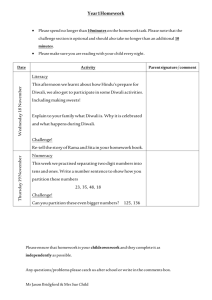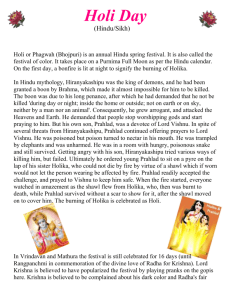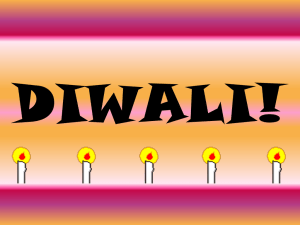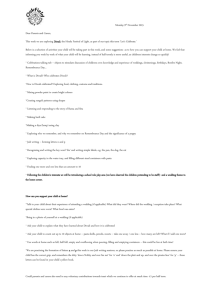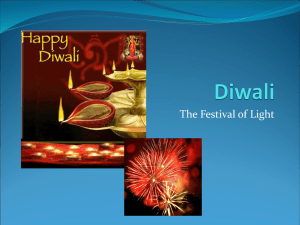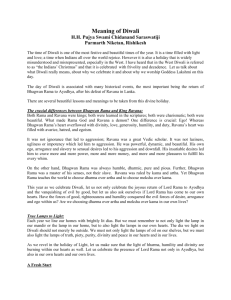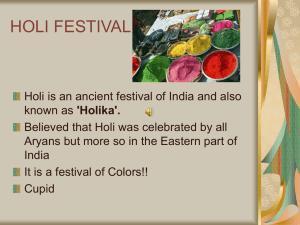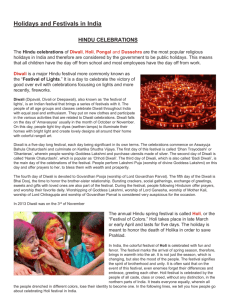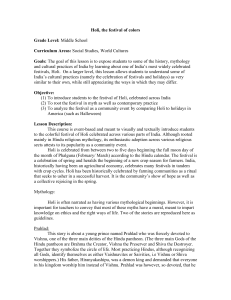hinduism holi and diwali
advertisement
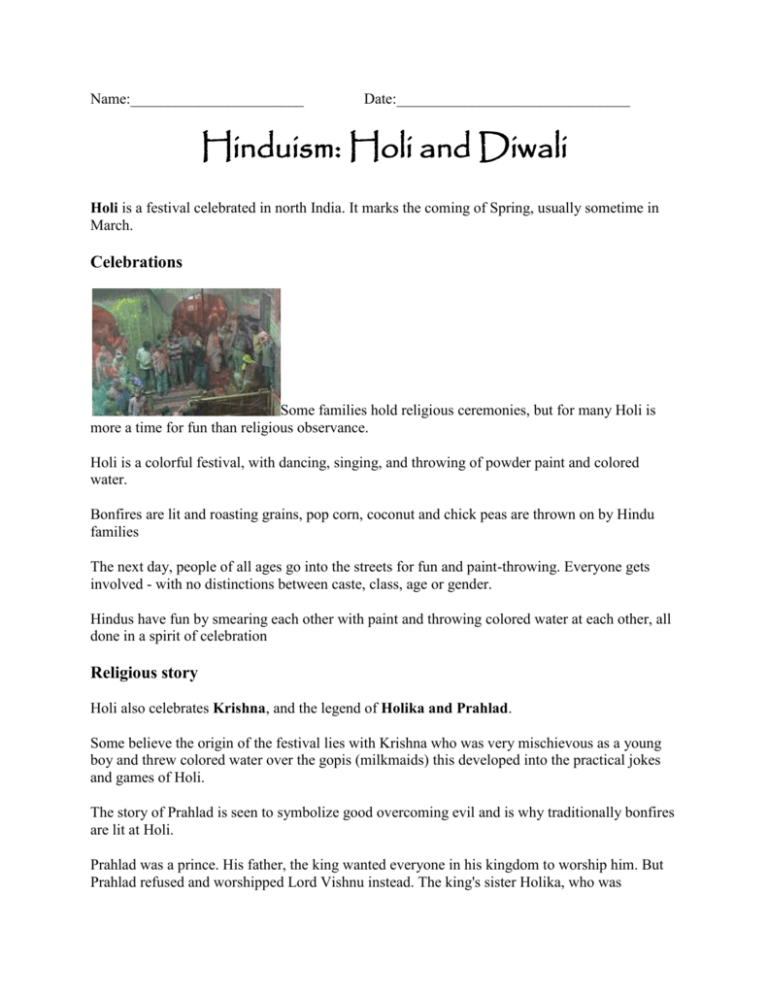
Name:_______________________ Date:_______________________________ Hinduism: Holi and Diwali Holi is a festival celebrated in north India. It marks the coming of Spring, usually sometime in March. Celebrations Some families hold religious ceremonies, but for many Holi is more a time for fun than religious observance. Holi is a colorful festival, with dancing, singing, and throwing of powder paint and colored water. Bonfires are lit and roasting grains, pop corn, coconut and chick peas are thrown on by Hindu families The next day, people of all ages go into the streets for fun and paint-throwing. Everyone gets involved - with no distinctions between caste, class, age or gender. Hindus have fun by smearing each other with paint and throwing colored water at each other, all done in a spirit of celebration Religious story Holi also celebrates Krishna, and the legend of Holika and Prahlad. Some believe the origin of the festival lies with Krishna who was very mischievous as a young boy and threw colored water over the gopis (milkmaids) this developed into the practical jokes and games of Holi. The story of Prahlad is seen to symbolize good overcoming evil and is why traditionally bonfires are lit at Holi. Prahlad was a prince. His father, the king wanted everyone in his kingdom to worship him. But Prahlad refused and worshipped Lord Vishnu instead. The king's sister Holika, who was supposed to be immune to fire, tricked her nephew Prahlad into sitting on her lap in a bonfire in order to destroy him. But because she was using her powers for evil, the plan failed and Prahlad emerged from the fire unharmed, while Holika was devoured by the flames. In some parts of India effigies of Holika are burnt on the fire. Ashes from Holi bonfires are thought to bring good luck. Why is Krishna often shown as having blue skin? It is thought that a demon attempted to kill baby Krishna by giving him poisoned milk. This made the baby turn blue but he did not die and the demon shriveled up into ashes. Don't people get upset when colored paint is thrown at Holi? People throw powder paint (called "gulal") at each other (yes, even at complete strangers) and no-one seems to mind. The air is often bright with clouds of colored powder. You can throw paint at strangers, soak your friends with colored water while saying "don't be offended, it's Holi", and, unless you're very unlucky, no-one will be upset. (But don't try this outside India!) Diwali: Festival of Lights Diwali is perhaps the most well-known of the Hindu festivals. The word Diwali means 'rows of lighted lamps'. Diwali is known as the 'festival of lights' because houses, shops and public places are decorated with small earthenware oil lamps called diyas Celebrating Diwali For many Indians this five day festival honors Lakshmi, the goddess of wealth. People start the new business year at Diwali, and some Hindus will say prayers to the goddess for a successful year. Lamps are lit to help Lakshmi, the goddess of wealth, find her way into people's homes. They also celebrate one of the Diwali legends, which tell of the return of Rama and Sita to Rama's kingdom after fourteen years of exile. In Britain, as in India, the festival is a time for: spring-cleaning the home, wearing new clothes exchanging gifts (often sweets and dried fruits) and preparing festive meals decorating buildings with fancy lights. huge firework displays often celebrate Divali. In India Hindus will leave the windows and doors of their houses open so that Lakshmi can come in. Rangoli are drawn on the floors - rangoli are patterns and the most popular subject is the lotus flower. The meaning of Diwali The festival celebrates the victory of good over evil, light over darkness and knowledge over ignorance, although the actual legends that go with the festival are different in different parts of India: In northern India and elsewhere, Diwali celebrates Rama's return from fourteen years of exile to Ayodhya after the defeat of Ravana and his subsequent coronation as king; In Gujarat, the festival honors Lakshmi, the goddess of wealth; In Nepal Diwali commemorates the victory of Lord Krishna over the demon king Narakaasura; In Bengal, it is associated with the goddess Kali. Why isn't Diwali celebrated on the same date each year? The Hindu calendar is based on the lunar cycle and the movement of the moon, unlike the conventional Western (or Gregorian) calendar. The result is that Hindu festivals move about the Western calendar from year to year. Diwali, for example, falls on the date of the new moon between the Hindu months of Asvina and Kartika. Usually this is in October or November. What is the story of King Rama and the demon Ravana? Ravana was the wicked king of the island of Sri Lanka. He was so evil he is shown as having ten arms and ten heads. Ravana kidnapped the wife of Rama. After a great battle Rama killed the demon and recovered his wife. Rama's return with his wife Sita to Ayodhya and his subsequent coronation as king is celebrated at Diwali. When Rama and Sita first returned to Ayodhya it was a dark moonless night and they couldn't see where they were going. Their people put little lamps outside their houses so that the new king and queen could find their way, thus beginning the tradition of the festival of lights.


